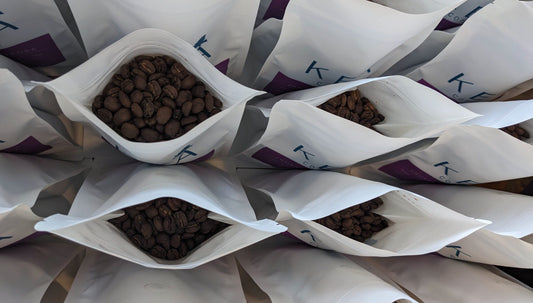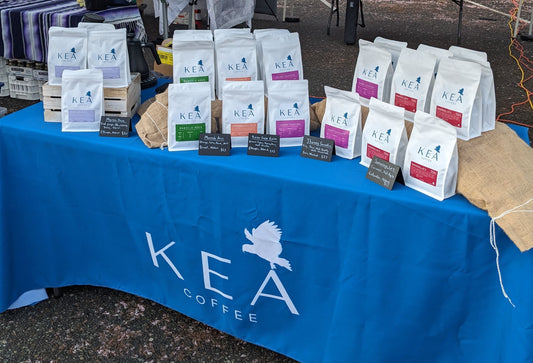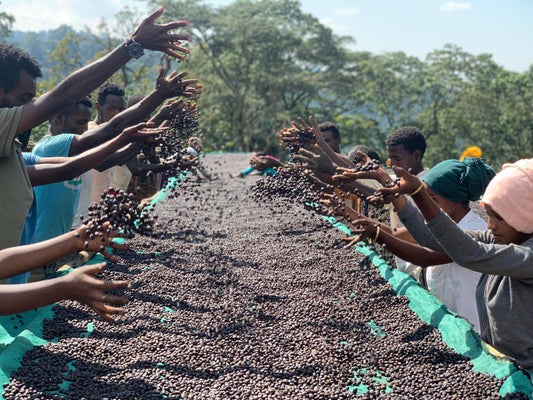Fruity.
Sweet.
Cupfulls of fresh berries, jams and mouth watering ripe fruits.
Some of our all time favourite coffees are naturals.
But brewing them can be a little ... finicky.
Most natural processed coffees do well to be brewed a little differently to a washed processed equivalent.
Today, we're going to run through some tips and tricks to help you brew better natural processed coffees.
So before we dive in, maybe take a quick pause and go flick the kettle on. We've got some experimenting to do!
What you need to know to brew better natural processed coffees
1. Naturals tend to be a little more brittle.
... this means more fines when grinding.
2. Naturals are often a little less dense than their washed counterpart might be.
... this means they extract quicker.
3. Naturals teeennnd to be sweeter. They're usually fruit forward, with a little less acidity.
... so depending on what you want to do with your brew, you might want to favour a particular brew method or recipe to either help highlight that or dial it back.
What device should I use for a natural processed coffee?
You can brew great naturals with any brew method, so you if you have a favourite, start there.
We like a pourover for natural coffees, but many naturals will do well on an immersion style brewer like the Aeropress or even as a vibrant espresso option.
Usually, our first go-to will be either a cone shaped dripper like the V60 or a flat bottom like the Kalita Wave.
Each of those will highlight slightly different things.
You can read more about that on our post on the differences between flat bottom and conical brewers, but the short version is:
Conical brewers = highlight more of the acidity and brighter.
Flat bottom brewers = more balanced, higher sweetness, usually slightly less vibrant.
We'll often flick back and forth between pourover brewers when brewing natural coffees, just depending on what we're trying to highlight in that particular bean.
Take our current Guji natural for example from Layo Teraga.
This one comes out super light and bright on a V60, with lots of fresh red fruits and nice acidity. Switch to the Wave (flat bottom) and the cup is way more balanced. The vibrant fresh red fruits turn into cooked, jammy notes and the sweetness is brought way up. We actually did another post the other day where we brewed the Layo side by side 3 different ways to compare.
Brewing tips for better natural processed coffees
1. Grind slightly coarser.
Naturals will tend to extract a little quicker.
Maybe because they also tend to be a little less dense and the flavours can be pulled out easier.
The first thing we'll often try to do to compensate for that is to coarsen up the grind slightly.
This will bring down brew time a little to compensate, and keep the cup light and bright. Which is what we're usually looking to get to.
2. Use less agitation.
More fines means you're more like to clog the filter and stall or slow down the brew.
Particularly in the V60.
If you've ever tried a natural Ethiopian on the V60, I'm sure you already know what I mean.
Try to pour a tad more gently, in slow circular motions.
You'd be amazed at the difference it can make to vary how heavy/light you pour (flow rate) or change your pour height. One of the simple tips for brewing better pour overs that we always start with, is to experiment and be really mindful of how you're pouring.
As well as how you pour, consider how many pours you do.
Every time you pour you disturb the bed of coffee and the slurry is churned up. As it begins to settle again, fines get another fresh chance to make their way to the bottom of your cone filters first, where they can accumulate and stall a brew or slow it down.
If you're working with a particularly brittle natural that's producing lots of fines, try a pourover recipe that uses less pours.
3. Experiment with different brewers.
As we mentioned above, many naturals can work great on all brew methods.
And you might be surprised at the differences in the cups when you compare different brew methods side by side.
So play around with different brewers and see what you prefer.
If you've got a particularly troublesome natural that you're struggling to dial in on pourover, try it out on an immersion brewer instead and see what happens. We love brewing naturals on the Aeropress, and you'll probably find it a lot more forgiving.
4. If Natural espresso is your jam, increase your ratios.
Single origin naturals on espresso can be punchy, sweet, full bodied and absolutely bloody delightful.
To really highlight the sweetness of a good S.O on espresso, try to dose a little higher to push your extraction times up a little.
This will help you pull out more sweetness and lower the perceived acidity - which plays perfectly into where most naturals shine.
For the same reason, you might also want to increase your yield, to help you increase extraction of those sweet and fruity characteristics.
Try pushing your ratio up to a 1:2.5, or even a 1:3.





